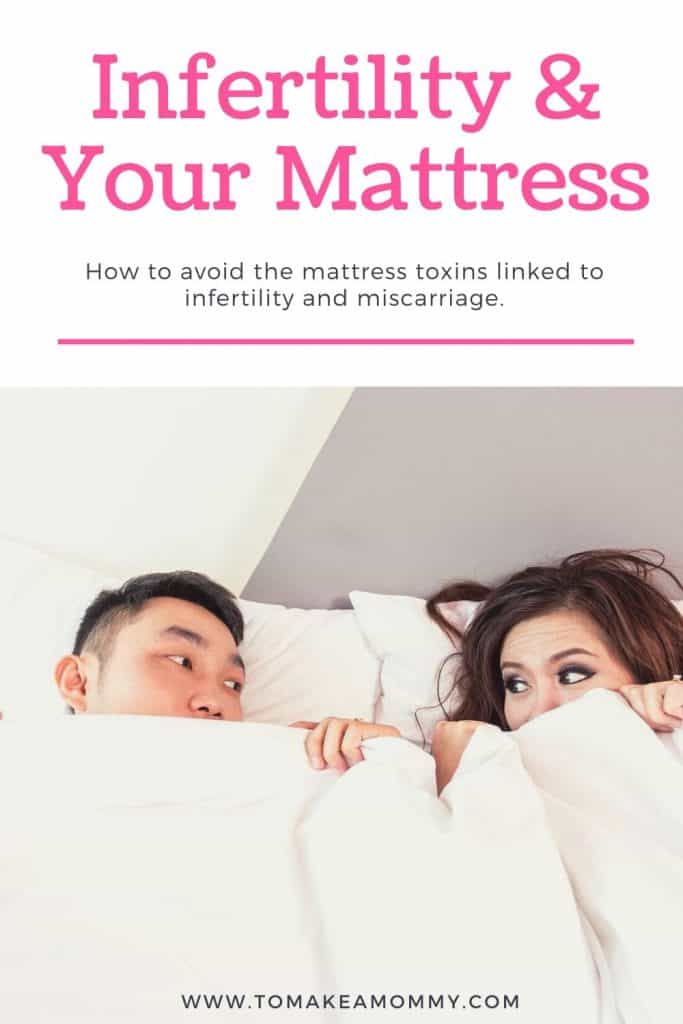
Whether you are new to non-toxic living, or you’ve already started banishing plastic from your kitchen, and phthalates and parabens from your personal care items, chances are you are still sleeping on a toxic mattress. And, chances are, that mattress is affecting your fertility, and may affect your pregnancy (because I know you will get pregnant soon!!). It will also affect the health of your whole family, and of your baby who will inevitably wind up in your bed, whether it is for nursing, co-sleeping, napping, or playing.
Hi! I’m Anna and I got pregnant naturally twice after the doctors said it was impossible because my eggs were bum! I had High FSH (34), Low AMH (.08), low antral follicle count (like, 1 or 3), endometriosis, MTHFR mutation, and multiple chemical pregnancies and early miscarriages. I did ALL THE THINGS including going super non-toxic in our lifestyles. Check out all my non-toxic shopping guides and posts here!
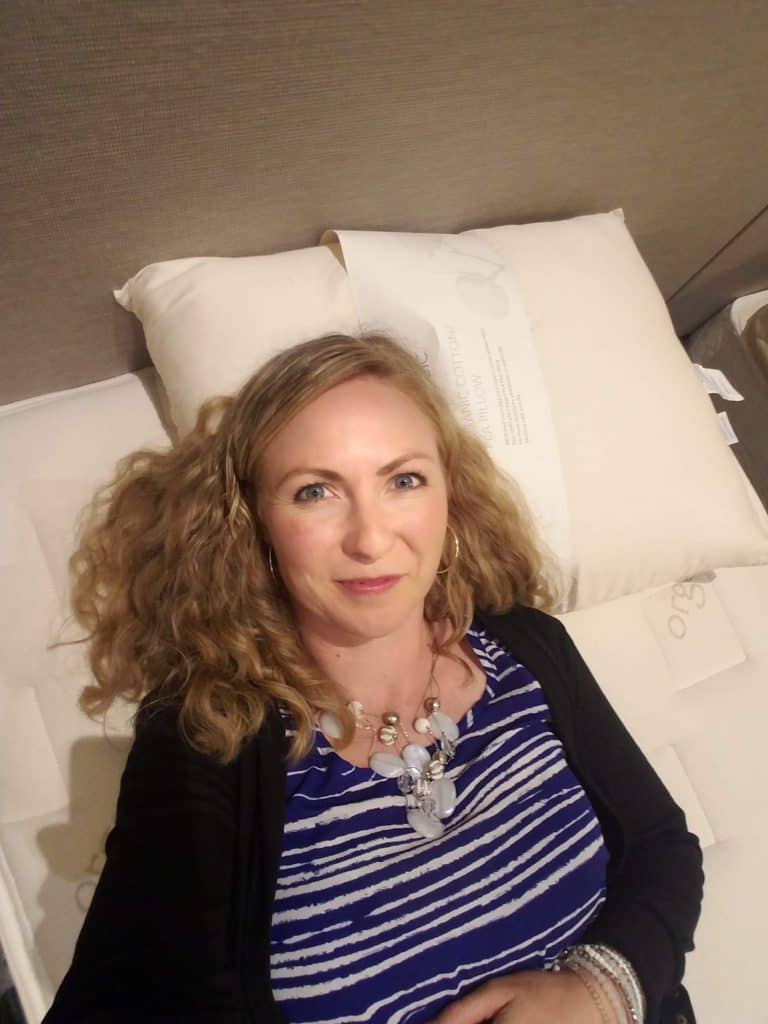
This post is sponsored by Naturepedic, the organic mattress company that makes the non-toxic mattresses we use and love in our family!
Table of Contents
The Best Pregnancy-Safe Mattress
In this blog post I’m going to talk about the toxins in conventional mattresses, especially flame retardants, and how they are linked to lower fertility rates in men and women. I’m also going to talk about toxins linked to other negative health outcomes, like cancer. Then I’m going to talk about how to find a safer mattress, how to understand different certifications, and which certifications are total bogus green-washing. Finally, I’m going to talk about the best, safest, most non-toxic mattresses for fertility, pregnancy, and overall human health.
Ready?
*This post contains affiliate links which at no cost to you provide me with some small change to help keep this blog running! If you decide to buy something I recommend, please consider clicking through one of my links to help support this blog and my family! Thank you!
Why Conventional Mattresses are TOXIC for Fertility (and Pregnancy!)
So, here’s the doom and gloom.
We’re supposed to spend 7-8 hours a night sleeping while trying to get pregnant, right? Most grownups spend at least 25% of their lives in their bed!
But what if the mattress we are sleeping on is literally lowering our fertility? Shooting ourselves in the dang foot.
The biggest problem with mattress chemicals is that they emit strong gasses that can make you and your family sick. Really sick. They’re linked to asthma, allergies, neurological disorders, SIDS, reproductive problems, thyroid disruption, and various forms of cancer. I’m going to go through each BIG Bad and what the evidence says about it.
Flame Retardants in Mattresses are linked to infertility and miscarriage
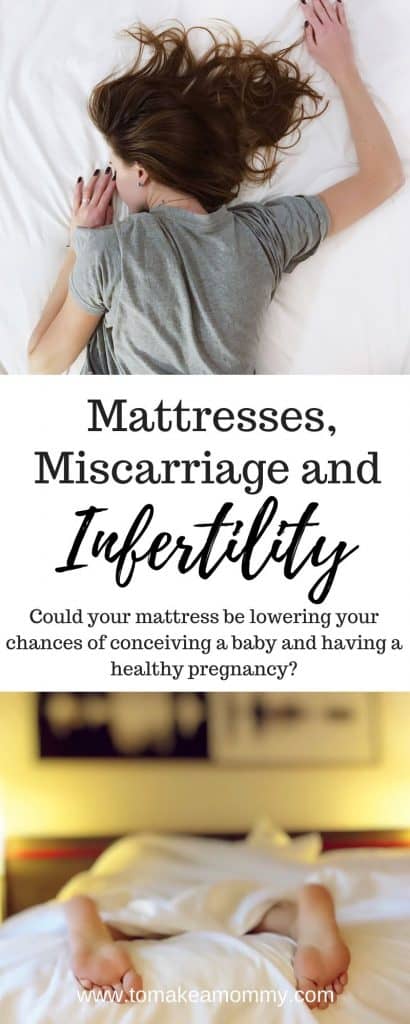
The worst offenders lurking in conventional mattresses are Flame Retardants- a whole array of scary chemicals including, polybrominated diphenyl ethers (PBDE), Firemaster 550, and Chlorinated tris. Even the government is concerned about this stuff!
Flame retardants are some of the worst endocrine disruptors and they off-gas for years after mattresses are purchased. Flame retardants disrupt thyroid function, reduce human fertility, disrupt normal fetal and child development, and may be carcinogenic. Various types of flame retardants have been linked to decreased sperm concentrations, reduced likelihood of clinical pregnancy, time to pregnancy, and higher miscarriage rate.
Ladies, you know this stuff is legit when WebMD talks about it. This is not just alternative medicine mumbo-jumbo. This is a real and present threat to your fertility and the health of your pregnancy.
The worst part about flame retardants is that they tend to bioaccumulate- this means that as you are exposed to flame retardants across your lifetime, the toxins build up in your body. We are exposed to flame retardants in our mattresses, our upholstered furniture, carpets, curtains, fabric blinds, televisions, computers, wires, cables, some building and construction materials, and transportation products, such as parts of cars, airplanes, and trains.
Now, stop. Don’t Panic. Seriously. The most important thing is to REDUCE your exposure as much as possible and prevent as much exposure to your future children. And I have an easy way- start sleeping on a safe mattress. Where you sleep and breathe for eight hours a day is giving you way more exposure than an airplane seat you flew on for a few hours.

Is my mattress safe from fire retardants?
Almost all conventional mattresses, and especially memory foam mattresses are going to have fire retardants. Some “organic” or “natural” mattresses are free of fire retardants, but some are not.
Unfortunately, mattress companies can be very sneaky about the information they share about flame retardants. For example, a “natural” company might claim that there are “no chemical fire retardants in the mattress.” But there IS a flame barrier inside the mattress. And, sometimes, there are chemical fire retardants inside that barrier.
Other times they will say we don’t use a certain fire retardants, but they are using some OTHER fire retardant. Companies are sneaky as all get out when it comes to hiding toxins in their mattresses.
By the way, Memory Foam mattresses are LOADED with toxic chemicals including fire retardants. And as the foam breaks down, more chemicals are off-gassed. Bad news.
Hey? WHY are there fire retardants in mattresses?
So, there’s this foam called polyurethane. And it is really, really comfortable to sleep on. And it is very inexpensive to use to make a mattress. And, it is really, really flammable. Like, so scary flammable the government got involved.
People got scared after mattresses were bursting into flame after a cigarette dropped on them, or a match from a candle. And, a house fire is pretty terrifying stuff.
The idea of mattresses bursting into flame was enough for first the state of California in the 1970s, and then the federal government in 2006, to make a rule that mattresses had to be reasonably flame retardant. The federal law requires that a mattress withstand a two-foot wide blowtorch for 70 seconds.
So, the mattress companies bought fire retardant chemicals (that had been used by the military and fire departments) to coat their polyurethane in. Problem solved- except you are now sleeping on toxic chemicals.
The good news is that there are good, safe, mattress companies that avoid using fire retardant chemicals by building their mattresses to not be flammable. It turns out good old wool, organic cotton, and metal innersprings don’t burst into flame the way polyurethane does.
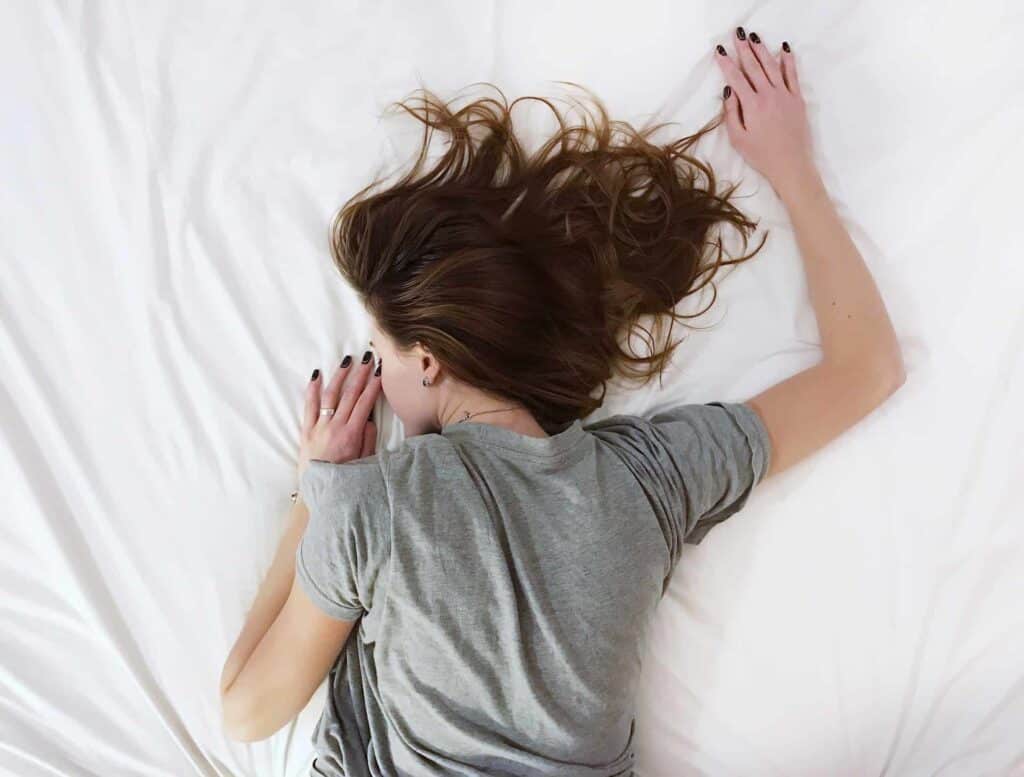
How to minimize Flame Retardants in your life
- Buy an non-toxic, organic mattress (I’ll give my favorites at the end of this post)
- Choose new furniture made without flame retardants or replace your old couch’s foam
- Research all baby products to make sure you are getting ones without flame retardants
- Use a HEPA vacuum every week to suck up dust that gets contaminated with these chemicals
- Be very careful removing old carpeting
- Replace bed sheets every week (dust may gather there)
Volatile Organic Compounds in Mattresses linked to miscarriage and poor sperm quality
Volatile Organic Compounds (VOCs) are also a problem in some mattresses; things like glycol ethers are linked to miscarriage and harm to semen quality.
VOCs are also linked to headaches, dizziness, cancers, and central nervous system problems. When you unwrap a new mattress and it smells, it is because of the VOCs. You don’t want that mattress. You can have a mattress with no flame retardants that still has VOCs.
Your body heat actually increases the VOC emissions from your mattress; so this matters the most on the mattress you sleep on (not your guest mattress that lies there cold). This study showed that even after six months of off-gassing (so it wouldn’t be noticeably smelly anymore), mattresses still emitted VOCs when people slept on them. The amount was toxic for babies and children, but not considered toxic for adults (but that is alone, without combining other VOCs you might be exposed to that WOULD give you a toxic load).
But, VOCs tend to build up in household air, so be sure to open your windows and air out your house whenever you can.
And of course fiercely avoid other common sources of VOCS while trying to conceive or when you are pregnant: paint, sprays, cleansers, air fresheners, fuels, pesticides, dry-cleaned clothing, and nail salons.
Formaldehyde is in Mattresses, and it is linked to infertility, endometriosis, and miscarriage
Remember how awful the science lab smelled on the day you dissected the frog?
Well, unfortunately, formaldehyde isn’t just in the science lab. It is found in fabrics, adhesives, and foams of traditional mattresses.
Formaldehyde off-gasses from the adhesives used in constructing mattresses and from polyurethane foam. Formaldehyde is linked to asthma, allergies, and cancers of the lung, nose, and throat.
According to the CDC, working with formaldehyde (like cosmeticians, funeral home employees, or laboratory workers), is linked to having fertility problems and miscarriages. There is also a study showing increased risk of endometriosis.
Even the U.S. government admits formaldehyde is a known human carcinogen.
And yet, even so called “natural” mattress companies are using formaldehyde in the fricking adhesives they use in mattresses. I’m sure they comfort themselves by knowing that the amount of exposure is way less than in those studies, and that is absolutely true.
Yes, there is a huge difference between some formaldehyde in glue in your mattress and working at a funeral home. But, if you’re going to buy a new mattress, why would you buy one that has any known carcinogens linked to infertility and miscarriage?
Also, mattress companies can be sneaky about the adhesives, so be careful. A “natural” mattress company may make a claim that there are no adhesives in between the layers of the mattress, but they don’t mention that all the coils are held together with adhesives. Ugh. It is not cool to be deceptive.
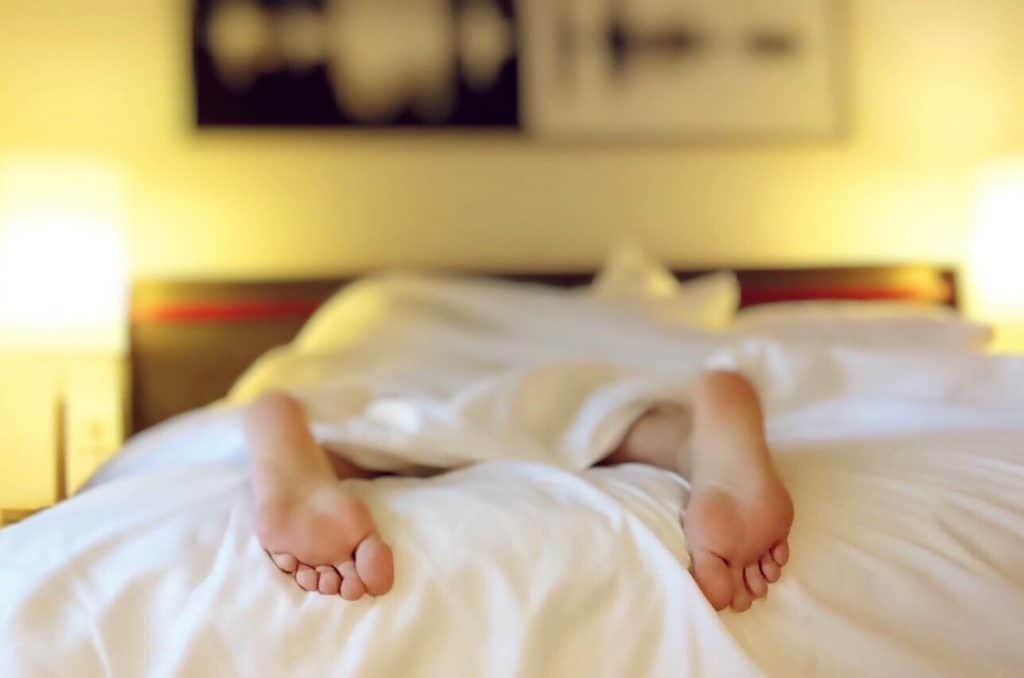
Is Memory Foam Toxic?
Unfortunately, Memory Foam is toxic, and problematic especially for pregnancy and when trying to conceive. Memory foams can have harmful toxins like those lurking in polyurethane foam, polyvinyl chloride, formaldehyde, antimony trioxide, isocyanates, and different types of petrochemicals.
The worst part is that memory foam is so highly flammable, that they have to use very high levels of fire retardants to meet the fireproof standards.
Some memory foam manufacturers have made bold claims about having no VOCs, but they have been sued in court for lying to the public. And they still have the fire retardants, formaldehyde, and other harmful toxins.
Here is a great Mother Jones article on toxic foam mattresses.
HEY, what about those metal coils? Are they safe from EMFs?
So, there used to be some concern that metal coils could somehow attract Electric & Magnetic Fields (EMFs), thus creating some kind of EMF health nightmare we were sleeping on.
Look, I’m totally worried about EMFs. But there is NO EVIDENCE that steel coils in beds collect or concentrate EMFs. This was just a “thought” one person had and put on the internet. There is no science behind it.
Unfortunately, it spurred a lot of “natural” mattress companies to make latex-only beds. Then they sourced synthetic latex, which is usually made from styrene, which is likely a human carcinogen. UGH.
(Don’t worry, there are fabulous organic mattress companies using certified organic latex beds).
Bottom line- Don’t be afraid of the coils. Be afraid of the carcinogens that are going to give you miscarriages. Are we clear? 🙂 Great.
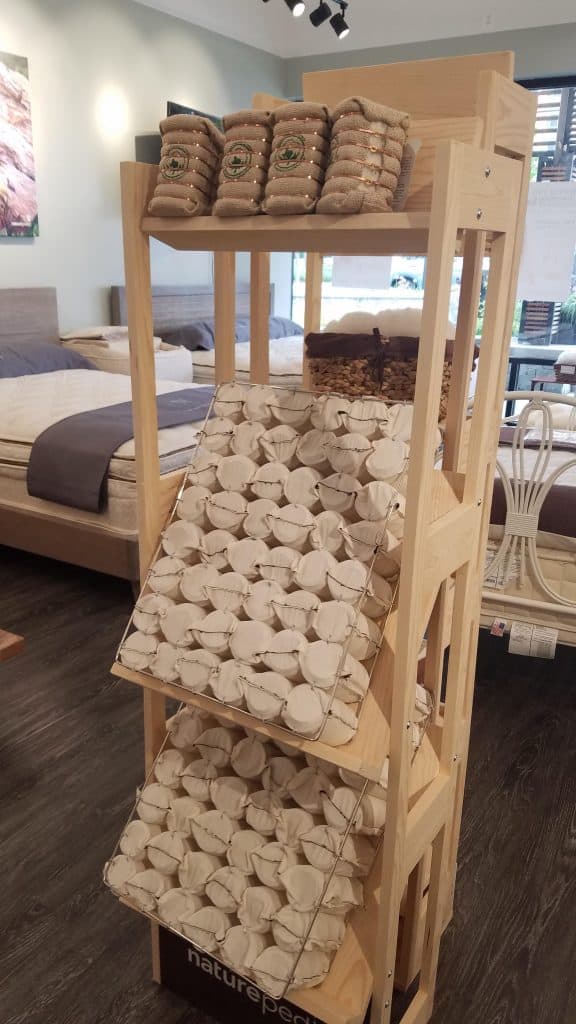
Do I NEED to get an organic mattress if I’m trying to conceive or pregnant?
I know. You’re wondering how dire the situation really is. Here’s the thing- it is different depending on what you are currently sleeping on.
- If you have a regular innerspring mattress, the older your mattress, the safer it is, because it has likely off-gassed much of the toxins. In fact, if you bought it before 2007 it might not have been treated with flame retardants. Replace with a new organic mattress when you can afford a SAFE, non-toxic, organic cotton/organic latex mattress.
- If you have a memory FOAM mattress– as the foam degrades, even more flame retardants (PBDEs) may be released. If you have a foam mattress, PLEASE REPLACE as soon as possible! See below for the most affordable, safe, organic option.
Side note: If you are willing to be hot, sticky, and have noise rustle whenever you move, you can wrap your older mattress in a very affordable vinyl-free polyethylene to stop off-gassing. It’s like sleeping on a potato chip bag, but it works. They sell pre-made wraps for crib mattresses, but for your bed you’ll have to just buy the Polyethylene and wrap, wrap, wrap.
Okay, Anna, I’m ready to deal with this issue. What is the best organic mattress for fertility, and is it going to break my bank?
How to Shop for an Organic Mattress– What Certifications Mean
Alright, so you know you want no VOCs, no formaldehyde, and no fire retardants. But what DO you want?
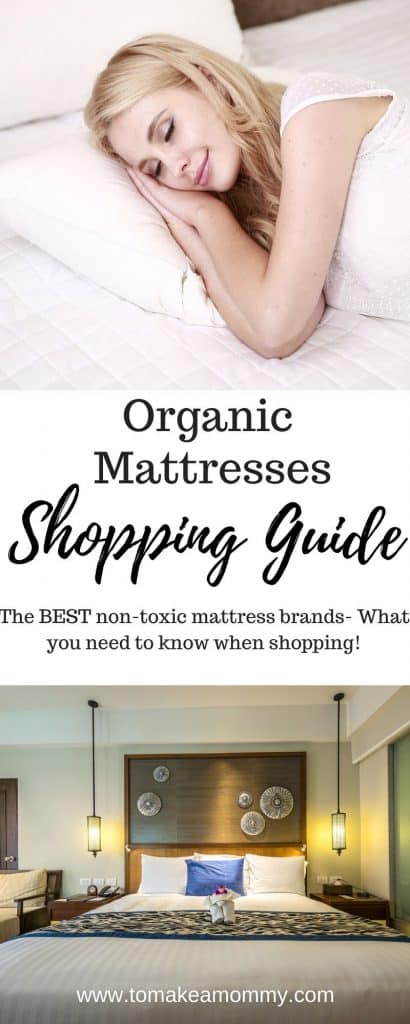
I’m here to tell you- you want a mattress that is GOTS (Global Organic Textile Standard) certified and/or GOLS (Global Organic Latex Standard) certified. Ideally you also want Made Safe certified. Now, let’s take a quick peek at all the crazy certifications you might see on a mattress or from a mattress company.
- GOTS certified- Global Organic Textile Standard. This is absolutely what you want to look for, and you want the entire mattress certified (not just the cover, for instance) with the mattress company’s name on it- not some supplier’s name which would suggest only part of the mattress is certified. If you get a GOTS certified mattress you will know it cannot have polyurethane foam, it will be at least 95% organic content, and will not contain most hazardous chemicals. Ensure that your mattress company additionally promises NO chemical fire retardants at all.
- GOLS certified- Global Organic Latex Standard. Same as above- ensure that the certification is for the ENTIRE mattress if it is a latex-only mattress, and they aren’t just passing off a certification for a single layer, while the rest of the mattress is of questionable materials. Also be sure the certification is in the name of the mattress company, and not a supplier. To achieve GOLS, the product must have at least 95% certified organic raw material.
- Made Safe Certification– This certification is great because it certifies that the mattress is made with no known chemicals that cause cancer or disrupt hormones. Mattresses receiving this certification have really been scrutinized to make sure there isn’t anything dogdy hiding in there. (FYI, as a quick skip to the end, there are only three companies that currently have this certification- Naturepedic, Happsy, and Avocado Green. Guess which ones I’m going to recommend?). If you buy a Made Safe mattress you know you have purchased the safest on the market.
- OCS 100 Organic Cotton Standard– This certification is like a step below GOTS, and certifies just organic cotton parts of a mattress, not the entire mattress.
- Greenguard Gold Certification– Greenguard test for around 350 common VOCS and certified the mattress is free of those. Regular Greenguard certification (not Gold) tests for about 35 of the most common VOCs. They do not test or certify for flame retardants, phthalates, or PFAS chemicals. If you insist on getting a polyurethane memory foam mattress, make sure it has this certification.
- OEKO-Tex Standard 100 Certification– This is from Europe and certifies that the fabrics are free from things like BPA, heavy metals, and formaldehyde.
- Centipur-US Certified Foam– This certification was made by the polyurethane industry itself and does not guarantee you are safe from carcinogens or miscarriage related toxins. They ban some flame retardants, but not all, and promise Low VOCs. They also ban things that are never in polyurethane foam like heavy metals. There is nothing organic about these mattresses. If it is truly an organic or natural mattress, it will not have Centipur certification, because it will not have polyurethane foam.
The Safest Organic Mattress for Fertility and Pregnancy
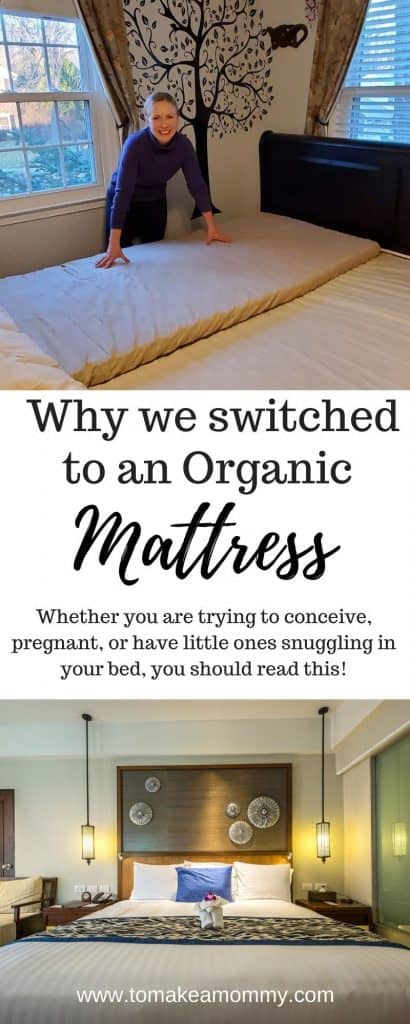
Once you go through all this data it actually becomes pretty easy to figure out the best and safest mattresses. We want the entire mattress GOTS certified, GOLS certified, and Made Safe certified. And, we want a company we can trust.
Made Safe certification is so onerous and new, that potentially we are willing to include some without it that are still GOTS or GOLS for the entire mattress but not yet Made Safe certified.
Please note that I owe a huge thank-you to Leah Segedie of Mamavation who did the initial research into which brands of mattresses had their own certifications and which did not. She has been the target of harassment by several of the brands below who were/are practicing shady stuff, and the whole non-toxic internet space owes her a thank-you for sticking her neck out on this research.
Note: I am not listing the BAD brands of mattresses. You know, the ones that you find at a regular mattress store. I do not want to be the target of their harassment. I’m a fertility blogger for goodness sakes 🙂
Here’s the deal- if a mattress company isn’t specifically saying they don’t have fire retardants, VOCs, etc., you can bet your bottom dollar that they DO. If you have a brand that you aren’t sure about and isn’t on my list- email the company and ask directly.
If you are from any of these brands and believe I have something incorrect, or perhaps you have recently acquired your GOTs or GOLs certification for your entire mattress, please contact me so I can adjust the listings. I applaud all efforts to make your mattresses more non-toxic, and I know many of you are actively working on this.
Best Brands of Organic Mattresses
These are all GOTS and/or GOLS certified for the entire mattress and the certification is actually for the mattress company. They also have MADE SAFE certification so you know they use absolutely no fire retardants, toxic adhesives, polyurethane foam, VOCS, etc.
- Happsy– The most affordable organic mattress company (woohoo), ALL of their mattresses are MADE SAFE certified! No adhesives are used, and only GOTs certified cotton and wool, and GOLS certified latex are used. I’ve slept on these at my parents house and they are very comfortable! Use the code ANNA10 to get 10% off your total purchase and free shipping!
- Naturepedic– This is the company that we choose to trust with our crib mattresses for our children, and for our own king-size family bed. Every Naturepedic mattress is MADE SAFE certified, in addition to certified GOLS and GOTS. No adhesives, everything is sewn by hand, or clipped, or heat sealed. This is also the only company with a completely Latex-Free option that is also GOTS certified for the whole mattress- we sleep on the EOS latex-free option because I have a latex allergy! We LOVE it. My children both sleep on the Verse mattress, and I think they are very comfortable as well. Use the code ANNA10 to get 10% off your total purchase and free shipping!
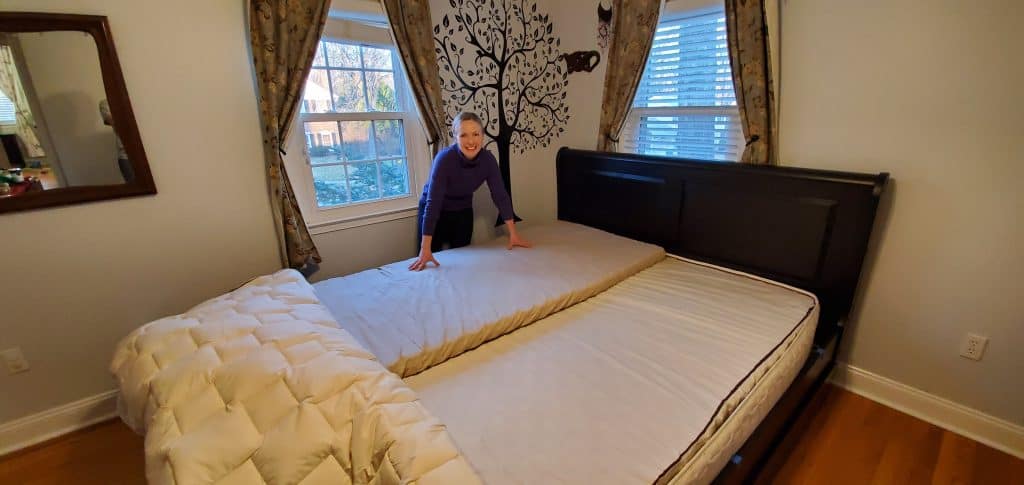
More Very Good Organic Mattress Brands
These brands make mattresses that are all GOTS and GOLS certified and they hold their own certifications. They do not have MADE SAFE certification (but they potentially could in the future). If you’ve already bought one of these, sleep easy, these are great. If you haven’t already made a purchase, grab one from above and support the companies making the effort to get Made Safe certified!
- Lifekind– Every mattress is GOLS or GOTS certified
- Organic Mattress Incorporated (OMI)- every mattress GOLS or GOTS certified
- Obasan- Holds GOLS and GOTS certifications in their name for their own factory and their entire mattresses– also we sleep on their Countour Organic Pillows and they are OUT OF THIS WORLD they are so comfortable!
- My Green Mattress– In 2019 acheived GOLS & GOTS certification for their own factory, and has a latex free option
- Soaring Heart is probably in this category, but they did not respond to my inquiries asking to confirm.
Other Organic/Natural Mattress Brands that I’m Just Not Sure About
Okay, so let me first say that these brands are still in general way safer than traditional mattresses. And, some of these companies are truly trying to be super clean- they are just in the middle of their journey.
For example, a year ago Avocado was still using a supplier’s certificate, and My Green Mattress wasn’t fully certified. Now they are. For many of these companies, its a journey.
I get my most angry when a company claims they have an organic mattress, but they only hold the certification for something small- like a mattress topper. Or, they hold no certification. Check if the company you are looking at holds GOTS certification in their own name here– make sure it says its for the whole mattress, not just a topper or sheets.
This is not okay.
***When they don’t have GOTS/GOLS certification for the entire mattress, we don’t know what other sneaky things might be in there. And worse, they can make the impression that the entire mattress is certified organic, when it isn’t. ***
Most of these claim to be free of fire-retardant chemicals.
The problems that get them in this category are one of the following:
- Only some of their mattresses are certified organic, but some aren’t, and its hard or impossible to tell which is which.
- The entire mattress isn’t certified, and/or certifications are held by other companies, not by the factory that assembles them. So maybe their latex supplier (or ONE of their latex suppliers) is certified organic, but the rest of the mattress isn’t, meaning anything could be lurking in there (adhesives, etc.). This is the worst when only something small is certified organic- like their mattress topper- but the rest is not.
BEFORE YOU FREAK OUT IF YOU BOUGHT ONE OF THESE– these are still mostly way better than a conventional mattress! They still have some organic materials, and avoid the harshest fire retardents and likely have very low if now VOCs.
- Brentwood Home (1 & 2)- Uses polyurethane memory foam (boo) and a silica sand sand layer for fire protection instead of chemicals (better). Has organic certification for some parts of some mattresses, but only one mattress is certified for the entire mattress- the Cedar Natural Luxe.
- Plush Beds (2)- Some mattresses appear to be fully organic certified, but many do not. In the past they didn’t hold their own certifications, it looks as though they do now. They have memory foam mattresses that are Greenguard certified, which is about as good as memory foam can get, but doesn’t cover all your bases (see above, re: certifications).
- Eco Terra (2)- Wool and cotton is certified organic, but latex is not. Only parts of mattresses are certified, so we don’t know what else is in there.
- FloBeds (2)- Cotton and wool materials are certified organic, but latex is not. They use what they call a “non-toxic water based adhesive” just on their king size mattresses, not twin or queen.
- Savvy Rest (1&2)- This one is confusing- they hold their own GOTS certification for the mattress, but it looks like every mattress they make has latex. I suspect they are working on GOLS certification, but for now it is confusing that they are claiming organic mattresses with non-organic latex.
- Awara (2) – Cotton is organic, latex is not. That means we don’t know what else might be in there, since the entire mattress is not certified. I can’t find the certification in their name, however. What worries me the most is on their website they say there are no “TDCPP or TCEP “Tris” flame retardants.” So what about all the others?
- FloBeds(2) They claim “100% certified pure ingredients” but their latex is not certified organic. So just their cotton and wool are certified organic, but the certifications are not held by FloBeds, but by their supplier.
- My Essentia (2)- Claims to be the world’s only natural memory foam (?). Some latex is certified organic, some is not. They say they have a GOLS/GOTS certified factory, but the organic cotton certification is just for the mattress cover. They use adhesives, although they claim they are safer. They use a mystery proprietary flame retardant that is a kind of plastic related to Kevlar. I’m confused about why some big-name “green” bloggers love this brand! I think its because they just really want the comfort of “memory foam.”
- Avocado– (1) A sister company of Brentwood, Avocado is currently under a lawsuit for potential false advertising, and for not adhering to their many excellent certifications. While they have GOLS and GOTS certifications for some of their mattresses themselves, and a MADE SAFE certifications for their Green Mattresses, I would skip this company until we have the results from the class action lawsuit.
Even Dodgier. Total Greenwashing in the Mattress-sphere. Avoid for sure.
Fire Retardants, VOCs, you name it, you gotta worry with these guys.
- Saatva – Although they claim their outer cover is organic cover, I can’t find the certifications. Their memory foam is not Greenguard certified. There is no promise that there are no adhesives, VOCs, or chemical flame retardants.
- Zenhaven– Made by Saatva, and has no certifications.
- Loom & Leaf- Another Saatva spinoff, only has CentiPUR certification, not clean.
- Tuft & Needle– Not non-toxic. Has a strong smell. DOES have Greenguard certification which makes them better than the others in this category. They have CentiPur also, but as you saw above in the certifications section, that really means nothing.
- Intellibed– They definitely use foam- soy based and polyurethane. Their fire blocker is proprietary. While they look insanely comfortable and my back relaxes just watching the ads on their website, they hold no certifications other than the dodgy CentiPur.
I have a Latex Allergy, are there any Organic Mattresses that are Latex-Free?
I find it so interesting that so many of my readers struggling with infertility have latex allergies. I certainly do!
We were sleeping on latex for years while I was having horrible reactions to band aids. It is so weird to think that my mattress could have been causing low-level inflammation.
Now, most “natural” latex mattress companies say that it doesn’t matter because the allergic reaction is to the protein in medical latex products, and that protein isn’t there in natural rubber latex. Is it true? We don’t know. Maybe.
We do know that some studies have shown that proteins do remain in mattresses made of natural rubber latex. There is one story that floats on the internet of a woman named Molly who had a terrible reaction to a latex mattress. It seems to have lived on a page called latexallergyresources.com which no longer exists. Other than that, we only have speculation.
Mainstream doctors are worried about people with severe latex allergies having anaphylaxis to their mattress. There is no evidence this might happen. They are also concerned about children sleeping on latex, being over exposed, and developing allergies. But this study seemed to suggest this wasn’t happening.
Here’s my problem; I’m not worried about anaphylaxis. I’m worried about long-term exposure that might be causing low-level constant inflammation that might lead to health issues like, unexplained infertility or repeated early miscarriage. It bears repeating- there is no evidence for this, this is just what I’m worried about given what we know about things like dairy and gluten allergies affecting fertility.
But, it is was enough to make me find a safe, organic mattress, made without any latex.
Please note, however, that after having ensured our house was latex free, I was gifted the most comfortable pillow in the world- an Obasan Contour Organic Pillow- and now I am sleeping on an organic latex pillow. I can’t give it up. It’s like an addiction. I know, I’m terrible.
The latex-free organic non-toxic mattress we sleep on!
We sleep on a GOTS certified, MADE SAFE certified, latex-free EOS mattress from Naturepedic. We love it, and I sleep easy knowing that there isn’t any latex that might be causing long-term low lying inflammation.
Naturepedic also makes latex-free organic crib mattresses, just to avoid any chance of sensitization of latex allergies to the smallest of us. That is what we purchased for our children.
Our children both now sleep on the Verse latex-free kids mattress by Naturepedic.
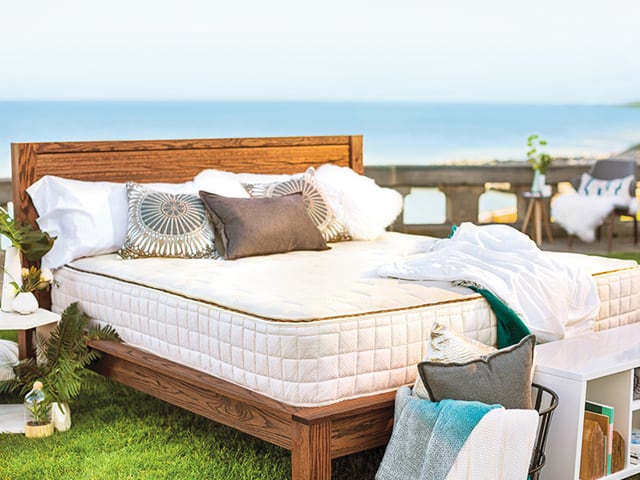
Are you ready to make the switch to an organic mattress?
After you make your decision, leave a comment on this post and tell us what you choose! I’d also love to hear about the comfort of various mattresses. It is easy an reasonably affordable to try multiple different kinds of non-toxic deodorants, feminine pads, or hair products, but it isn’t the same with mattresses!
Be sure to sign up for my newsletter so you learn about any updates to this post. Also, pray for me that angry mattress companies don’t come yelling :-). XO, be safe out there ladies!
Want to get pregnant fast?
Love lists? Me too. Grab my 79 Things I did to transform my life and get pregnant in less than 3 months after 2 years of infertility and miscarriages! Totally free!
Anna Rapp is a fertility journalist and non-toxic living expert. When Anna Rapp was struggling with infertility and recurrent early miscarriage, she was diagnosed with diminished ovarian reserve, High FSH, low AMH, low follicle count, endometriosis, and an MTHFR mutation. Despite being told donor eggs were her only solution, Anna used her graduate training in research methods and analysis to read everything she could find on fertility and egg health. Ultimately, she lowered her FSH and got pregnant naturally (twice). She blogs about how she did it and encourages her readers to take charge of their fertility journey and get happy, healthy, and pregnant!
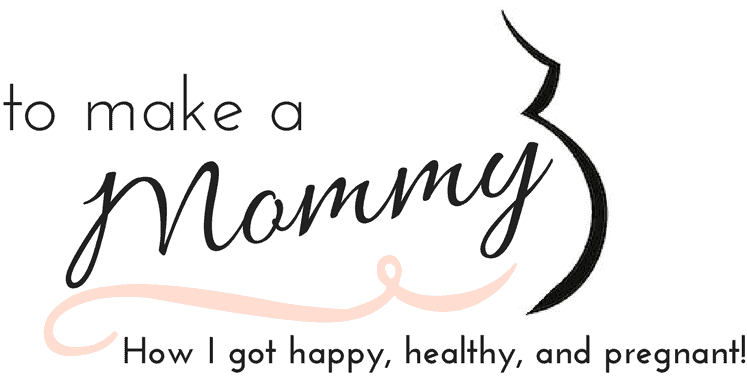

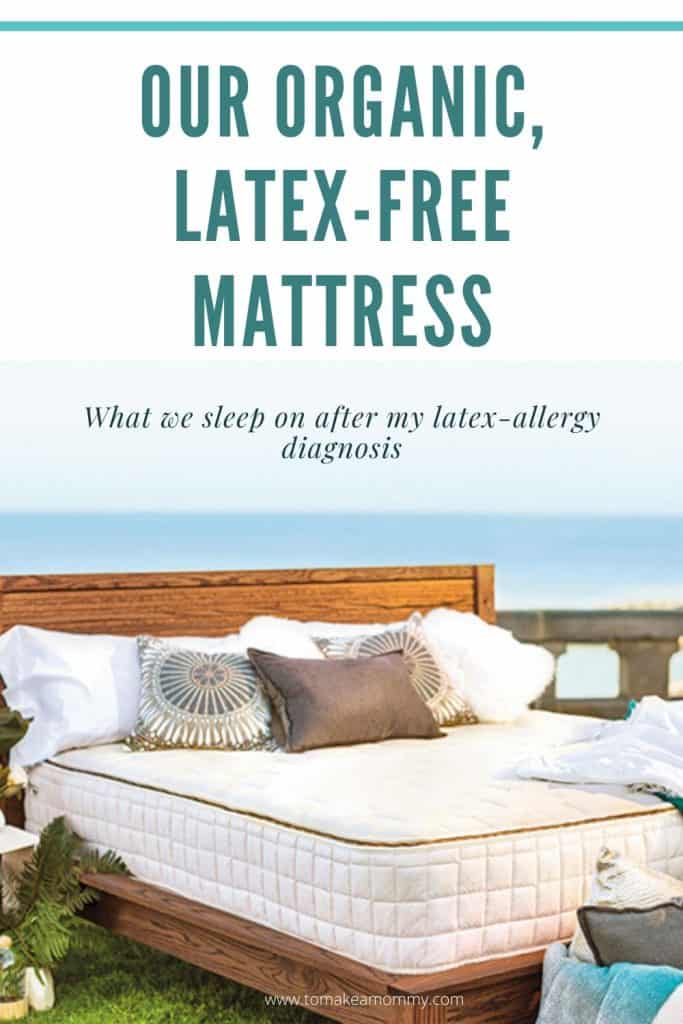
This is such a great article and a really really awesome way to eliminate toxins in the home. We just bought the Brooklyn Bedding Bloom. I hope it would pass your test. I did ask many questions about flame retardants, glued, formaldehyde etc. We wanted a softer bed which is tough to find so that ultimately led us to pull the trigger. 😬
Laura,
How are you liking it? Did if offsmell at all when you got it?
We love our Avocado mattress and pillows!
Yay! I love to hear that!
Hi Anna, thank you so much for the article! I love how you manage to bring new and relevant content to all of us 🙂 Question – do you have any thoughts on the Lullaby Earth crib mattresses? Also, is there a specific crib mattress cover you’d recommend? (Sorry for the baby-specific questions – in the middle of wading through all that info now and always love a little guidance!)
Hi Jen! Sorry I missed this! We got the Naturepedic crib mattresses, but it does look on Lullaby Earth’s website that their crib mattresses are Made Safe certified also!
Very interesting. Do you know if Jensen mattresses (/beds) are toxic? This is one of the most common brand in my country and – I believe – in all of Scandinavia. I tried looking on their website and they state that “The wood and metal surfaces, as well as the textiles, are treated without the use of flame retardants” but does that mean the whole mattress or are they saying it like that because something in there does have FR? They also note that they have the Swan label but does that compare to GOTS, GOLS etc?
https://jensenstore.com/collections/environmentally-friendly-beds
HI Runa! Sorry for the late reply. I’m on their website and having a hard time figuring out what their mattresses are made of! Can you figure it out?
We bought a joybed mattress – which is foam free, made of wool and cotton. It has organic certification for the cover but oxotec for the inside of the mattress. Not sure about glues etc Mattresses are so important! I’ll be emailing the company to check on these issues.
Hi Maggie! Did you get an email back from them? I image wool and cotton will be fine as long as there are no fire retardants!
Hi Anna, thank you for this great article, I wish we could go back 1 year when I bouth my brand new mattress. I bought the Purple mattress, I am not sure if you heard of it. It is not organic but certiPURE US certified. Do you have any insight as to if that makes them safe? Or did I spent all my money to sleep on toxins?
This is from their website:
CertiPUR-US certified foams are:
✓ Made without ozone depleters
✓ Made without PBDEs, TDCPP or TCEP (”Tris”) flame retardants
✓ Made without mercury, lead, and other heavy metals
✓ Made without formaldehyde
✓ Made without phthalates regulated by the Consumer Product Safety Commission
✓ Low VOC (Volatile Organic Compound) emissions for indoor air quality (less than 0.5 parts per million)
Is there anything that you still would be concerned about or can I sleep safely? Would love to hear your input since you must have spent a lot of time researching all of this.
Thank you
Gazelle
I’m not a huge fan of Centipur certification, because its the industry certifying itself. That said, if you are going to get polyurethane foam, it is better to get Centipur certified. It will still have flame retardants and VOCs, just not the worst ones. Does that make sense? You’ll have to make your own decision!! Sorry for my delay in replying!
Thank you for this wealth of info! As always 🙂 We just ordered the Avocado mattress and are so excited! Do you have any bed sheet recommendations?
Yay!! I shared some bed sheet recommendations here -> https://www.tomakeamommy.com/how-to-make-your-bedroom-a-fertility-haven/
Organic cotton all the way!
Thank you Anna! this is crazy, so much burden on the consumer these days.
My husband and I recently bought a Leesa mattress. And based on the website, seems like we’re in the clear? https://support.leesa.com/hc/en-us/articles/234669767-Are-chemical-fire-retardants-used-on-the-mattresses-
What do you think? Concerned given your advice that some can be misleading.
Appreciate any help!
Hi Tanner!! So it is Centipur certified which is just the certification that the polyurethane manufacturers came up with themselves- it is certainly better than NON Centipur certified, but still allows for plenty of dodgy stuff. Also, I’m concerned about what material they are using for flame retardants, and why they don’t say? Maybe its just silica? Why don’t you email them and specifically ask what it is made up of?
Anna, we bought our (brand name not mentioned) memory foam mattress that was most likely full of toxins without any certifications about 4 years ago. What’s interesting is our fertility troubles started shortly afterwards (not saying it’s linked, but most likely hurt instead of helped us). We JUST bought our Avocado mattress yesterday and our looking forward to using it in a couple weeks! I do have a question, is there a non-toxic waterproof mattress cover you use? I noticed that both Avocado and Naturpedic offer one but they contain polyurethane. Also, which nontoxic affordable foundation option from ikea do you recommend?
Hi Tanya!! So excited you got your Avocado! Hope you love it!! We use Naturepedic’s. They contain polyurethane in less than 2% that is certified by GOTS- and its not polyurethane foam. Honestly, I thought they used food grade polyethelene like in their kids and baby line, and was suprised to see this. Here are two articles explaining why:
https://www.naturepedic.com/blog/2016/03/ask-naturepedic-whats-in-your-protector-pads and https://organiclifestyle.com/natural-mattress/organic-waterproof-naturepedic
Given what I’ve read I feel comfortable continuing to use my waterproof pads!
For Ikea, go with the unstained version if you can- there will still be some glue in the frames, but you’re reducing your VOCs greatly by getting the unstained!
Thank you for a great post, Anna. It is sad that big brands like Saatva does not care about their customers by using uncertified materials in their products. You should always double check what you are buying…
Thanks Anna for the great post. We bought an organic mattress which we sleep on it now. But in our guest’s room we still have a conventional non-organic mattress which off course we don’t sleep on it but I’m not sure if it still off-gas chemicals into air. Any ideas?
Leila,
I wouldn’t worry about it unless it is new. If it’s old, and infrequently used, spend your money elsewhere. Upgrade it when your baby who is on the way grows up and needs a safe mattress!
Anna
golikov1r@mail.ru
fantastic issues altogether, you simply won a new reader.
What could you recommend in regards to your post that you just made some days ago?
Any certain?
What about
the metta mattress brand.
Hi!
Just came across your page in doing some research as my husband just bought a mattress topper off Amazon without me knowing and he thinks it’s the greatest thing ever but I’m not so sure. Supposedly it’s CertiPure-US rated safe but it’s made in China. I also don’t like that it’s herbal infused with “soothing lavender” and that’s all the info I can find on the scent. We are currently TTC and I’m concerned about the scent with getting/being pregnant. Any info you can provide would be great.
Thanks!